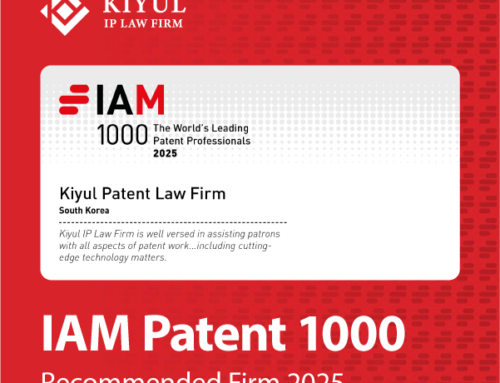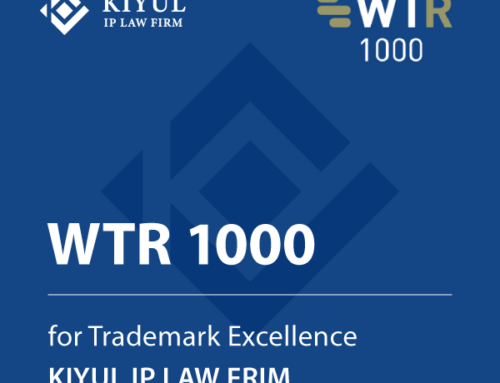ㅤ
Hello, I’m Mooyun Shin, a patent attorney at KIYUL IP LAW FIRM.
I’d like to introduce several significant changes to South Korea’s intellectual property (IP) system, set to take effect between late 2024 and 2025. These updates will impact patent enforcement, examination procedures, and trademark registration, making them essential for foreign patent attorneys and global businesses operating in or with South Korea.
Below is a summary of the key amendments, their effective dates, and the practical implications you should consider.
ㅤ
1. Patent Act Amendments (Effective December 27, 2024)1.1 Export as an Act of Patent Infringement
- Previous Rule: Patent infringement was limited to manufacturing, selling, or using patented products within Korea.
- New Rule: The export of products that infringe Korean patents now constitutes patent infringement.
◆ Implications:
- Companies manufacturing in Korea for global distribution must conduct thorough prior art and clearance searches to avoid inadvertent infringement.
- Expanded enforcement for Korean patent holders:
- Patent holders in Korea can now enforce their rights against products exported from Korea that infringe their patents.
- Even if the product is intended for overseas markets, it may still be subject to patent enforcement in Korea.
- Customs measures can be used to block the export of infringing goods, adding an additional layer of protection for patent owners.
- Companies using Korea as a global production hub should carefully evaluate patent risks and compliance strategies.
ㅤ
1.2 Strengthened Penalties for National Security-Related Secrecy Violations
- Key Provision: Violating a secrecy order for defense or national security-related inventions can result in up to five years in prison or a fine of KRW 50 million (approximately USD 38,000).
◆ Implications:
- Companies dealing with sensitive technologies must reinforce internal security protocols and handling procedures.
- Export control compliance should be reviewed to avoid potential legal risks when dealing with national security-related patents.
ㅤ
1.3 Restrictions on Pharmaceutical Patent Term Extensions
- Key Provisions:
- The total extension period is now capped at 14 years from the drug’s approval date.
- Only one patent per drug approval can be extended.
◆ Implications:
- Pharmaceutical companies must re-evaluate their patent portfolios and lifecycle management strategies to adapt to the reduced extension period.
- Companies should explore alternative strategies, such as secondary patents or combination therapies, to maximize patent protection.
ㅤ
2. Expanded Priority Examination for Emerging Technologies (Effective February 19, 2025)
- Previously, priority examination (fast-track) was only available for critical industries such as semiconductors, displays, and secondary batteries.
- Newly added sectors:
- Biotechnology
- Artificial Intelligence (AI)
- Advanced Robotics
- Carbon-neutral technologies (e.g., hydrogen-based technology)
◆ Effects:
- Companies in these sectors can receive a first office action in as little as two months, compared to the usual 18 months or more.
- This accelerated process helps innovators secure Korean patent rights faster, strengthening their market position both domestically and internationally.
ㅤ
3. Updates to the Patent Examination Process3.1 Faster Processing for Patent Prosecution Highway (PPH) Applications (Effective January 2025)
- Previous Rule: PPH applications were typically processed within four months.
- New Rule: The processing time has been reduced to three months, aligning with recent PPH improvements in the United States and Japan.
◆ Implications:
- Applicants seeking patents in multiple jurisdictions will benefit from faster decisions and improved international coordination.
ㅤ
3.2 Extension of Re-examination Request Period (Effective April 2025)
- Previous Rule: Applicants had to request re-examination within one month after receiving a final rejection.
- New Rule: The request period has been extended to six months, allowing more time for review and amendments.
◆ Implications:
- Applicants now have a significantly longer timeframe to reassess their patent claims and refine their applications.
- This change reduces the pressure on applicants, providing more flexibility in addressing examiner objections.
ㅤ
3.3 Change in Divisional Application Examination Order (Effective January 2025)
- Previous Rule: Divisional applications were examined based on the original (parent) application’s examination request date.
- New Rule: Divisional applications will now be examined according to their own examination request date, aligning with practices in the U.S. and Japan.
◆ Implications:
- Applicants can now manage their divisional application strategy with greater flexibility, deciding which applications to accelerate or delay independently.
ㅤ
4. Introduction of the Trademark Coexistence Agreement System (Effective May 1, 2024)
- Key Change:
- Prior trademark owners can now formally consent to similar or identical marks being registered.
- Previously, any mark deemed confusingly similar was automatically refused, regardless of private agreements.
◆ Implications:
- Foreign brands entering the Korean market can negotiate coexistence agreements instead of facing opposition proceedings or rebranding.
- This new mechanism provides greater flexibility in brand management and helps reduce unnecessary legal disputes.
ㅤ
Conclusion & Recommendations
◆ Strengthen Clearance and Compliance: With exports newly recognized as a form of patent infringement, manufacturers in Korea must conduct rigorous IP due diligence to avoid risks.
◆ Leverage Fast-Track Examination: AI, biotech, and robotics companies should take advantage of Korea’s priority examination programs to secure patents faster. The same applies to applicants utilizing the revised PPH system.
◆ Adjust Pharmaceutical Strategies: The new limits on patent term extensions require tighter lifecycle planning and alternative protection methods such as secondary patents.
◆ Negotiate Trademark Coexistence Agreements: Foreign companies can now negotiate agreements instead of facing immediate rejections, offering a smoother path for market entry.
ㅤ
By proactively adapting to these regulatory changes, businesses can strengthen their IP protection strategies in Korea and ensure smoother market operations.




